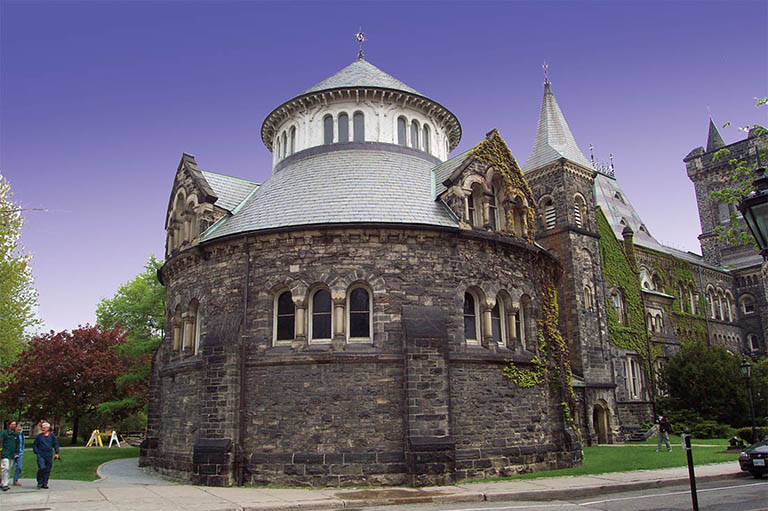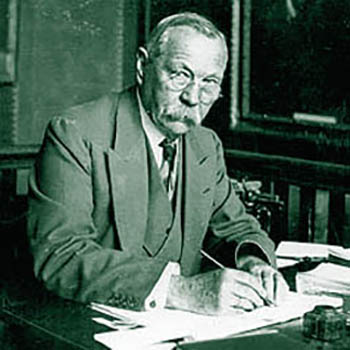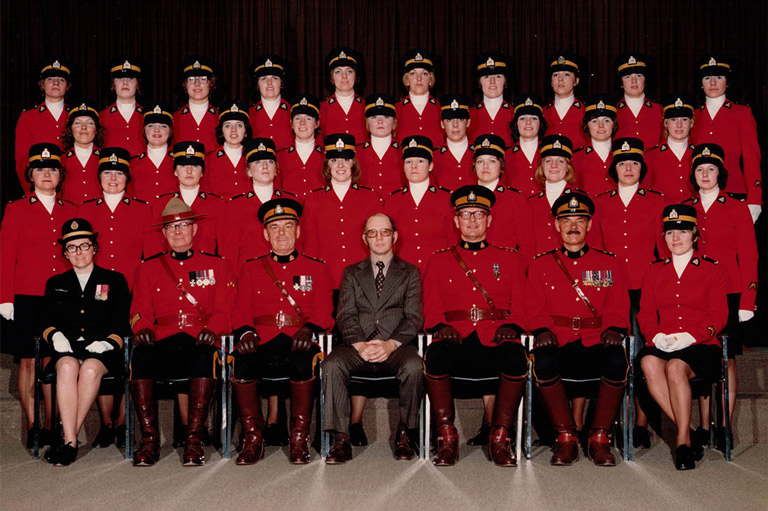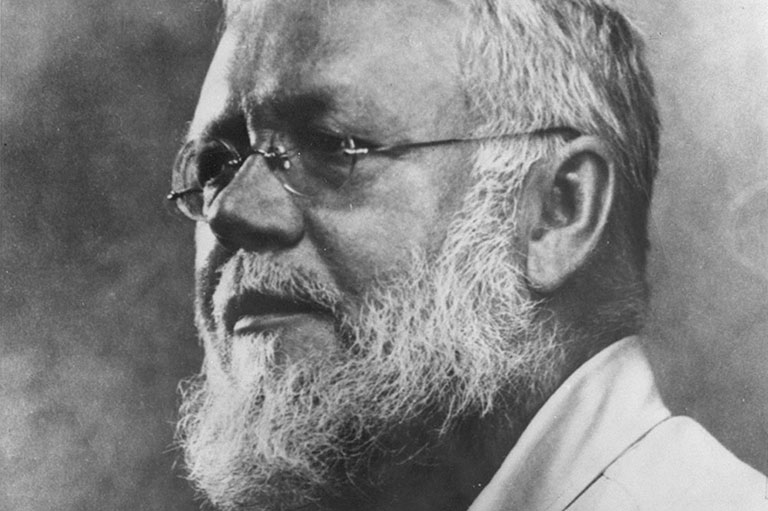Fine Chemistry

The train from Montreal rumbled to a halt in a billowing cloud of steam at the Grand Trunk Railroad’s station in Toronto on a cold, blustery, November day in 1858. Back in the train’s baggage car, conductor James Keeble took a key from his waistcoat pocket and unlocked the cupboard reserved for bonded goods. From the top shelf he removed a small box containing a pickling jar, sealed with wax.
Keeble knew the jar contained a human stomach, which had previously resided inside the body of Sarah King, a doctor’s wife who had died under very suspicious circumstances. But the railway conductor had no idea that this grisly package would make criminal history in Canada. All he remembered was the precise instructions he was given from Simon Davidson, the coroner in Brighton, 135 kilometres east of Toronto.
“Mr. Davidson told me not to let [the package] out of my custody until such time as I placed it in the hands of Professor Croft,” Keeble would testify later in court. True to his word, Keeble walked briskly along the plank sidewalks of the bustling city streets, carrying the package directly to the chemistry department at the University of Toronto, where he delivered it to Professor Henry Holmes Croft.
A short, wiry man with long, unruly hair and a Rasputin beard, Croft looked a bit the mad professor — which in some ways he was. Henry Croft’s talents as a chemist were already well established before he turned his attention to simplifying and improving the methods for detecting poisons. Just one year earlier, in 1857, Croft had gained notoriety when he succeeded in making oil safe to use in household lamps by deodorizing the high sulphur content of oil drawn from a well near Sarnia, Ontario.
But even the brilliant chemist could not have predicted that the contents of that pickling jar would take his name into the history books as Canada’s first forensic detective. Author John King wrote in his 1914 article, “McCaul, Croft, Forneri: Personalities of Early University Days,” that “Croft in his time saved some innocent men from the gallows, and it is just as certain he was instrumental in bringing to justice others of whom society was well rid of.”
Professor Henry Croft, born March 6, 1820, was a man shaped by the mercurial nineteenth century, his life touched by famous scientist Michael Faraday, Napoleon Bonaparte, Charles Dickens, the Fenians, and Wyatt Earp. Croft’s foray into the uncharted waters of forensic science was, for him, a natural choice. He was a maverick all his life.
As a young boy growing up in London, England, Croft had built and blown up his own chemistry lab several times before he was sent for a conventional education at an academy called Tavistock House. (After Croft graduated, Charles Dickens purchased the house, which is where he wrote Bleak House, Hard Times and A Tale of Two Cities.)
The teenage Croft showed little interest in following his father, William Croft, into the British civil service. An exasperated Croft senior sought the advice of his close friend Michael Faraday, who had already attained fame as the inventor of the electric motor. Croft considered his son a “wayward potterer in acids and stinks,” but Faraday knew talent when he saw it.
“Your son certainly has a wonderful aptitude for chemistry,” he told the concerned father. “Send him to Germany by all means and send him there at once.” So, in 1838, Henry Holmes Croft was shipped off to the University of Berlin to study under the noted professor Eilhard Mitscherlich, a former friend of Napoleon Bonaparte.
Under Mitscherlich’s influence, the eighteen-year-old Croft became fascinated not only with chemistry, but also with botany, zoology, and mineralogy. His proclivity for broadening his mind did not seem to extend to the tedious business of sitting exams, and Croft left the university without bothering to take his Ph.D. — even though he had headed a class that produced many famous scientists.
Before returning to England, Croft received one solid job offer in Germany. As a talented pianist, he often performed recitals for the king of Hanover, but he declined the king’s offer of a full-time job as his court musician.

Once back in England, Croft was quickly flagged by powerful people such as Faraday as “one to watch,” so it came as no surprise when the new governor general of Canada, Sir Charles Bagot, approached him with a plum job offer. And, six months later, Croft travelled to Canada to become the first professor of chemistry and experimental philosophy at the University of King’s College (later renamed the University of Toronto). Croft had just celebrated his twenty-third birthday.
His induction ceremony at the new college on June 8, 1843, struck a note of pure theatre. In front of the entire student body, Henry Croft, in his usual brilliant style, was demonstrating the ignition point of potassium in contact with water. A fragment of burning metal exploded through the air and set fire to the gown of the bishop of Toronto, Dr. John Strachan, who was also the college president.
The fire was safely extinguished, which is more than can be said for the animosity that ignited between the two men.
Later, Henry Croft became the champion of the movement to remove King’s College from the church’s control and turn it into a non-sectarian university. Six years after that, when government legislation made the transition official, Bishop Strachan was ousted and Croft was elected vice-chancellor of the new University of Toronto — but only after he was given an honorary degree.
In four decades at the University of Toronto, Henry Holmes Croft achieved iconic status and attracted a level of hero worship from his students. One of Croft’s students, Hodgson Ellis, who succeeded him as professor of chemistry at the University of Toronto, wrote in a 1901 tribute:
“He inspired in those students who were privileged to work with him not only respect for the master and enthusiasm for the work, but also and chiefly, love for the man. He was full of dry humor, thinking strongly and speaking fearlessly, but brimming over with kindness.”
Croft was recognized as one of the new breed of scientists eager to throw out the old scientific methods and try new tests and approaches. One such test he employed could detect the most elusive poison of that period, arsenic.
Also known as the “inheritance powder,” arsenic had been used for centuries by impatient relatives eager to dispose of an aging patriarch. Like many poisons, arsenic could mimic common maladies, tricking physicians into believing a victim had died of natural causes. Symptoms of constant vomiting, diarrhea, headaches, even convulsions, were routinely ascribed to gastric flu.
In the 1850s, toxicology was a crude discipline, not far removed from black magic, and doing very little to shed light on so many unexplained deaths. Napoleon’s poisoning by arsenic would not be uncovered by science until 170 years after his death.
The accepted test for arsenic, devised by European toxicologist Dr. Hermann Boerhaave, involved placing substances suspected of containing the poison on red-hot coals and “sniffing” out any strange odours. The test was so prone to failure that few judges and lawyers would prosecute a poisoning case. Forensic evidence was not trusted, much less accepted, in the court of law.
Over the next thirty years, Professor Henry Croft would challenge that skepticism through his relentless pursuit of scientific integrity, changing the landscape of the criminal justice system. Croft became the most sought-after forensic detective in Canada, serving as the expert witness at dozens of murder trials. He undoubtedly paved the way for specialized forensic science laboratories such as the first North American lab, founded in Montreal.

In 1858, Croft was a strong proponent of the work of brilliant English chemist James Marsh, who had developed the Marsh test for arsenic while working as assistant to Michael Faraday at the Royal Military Academy in Greenwich, London. As an eighteen-year-old “boy genius,” Croft had met Marsh on his many visits to Faraday’s labs.
Later, in Canada, Croft was clearly the right man at the right time to adopt the Marsh test, a test that could be used to detect minute amounts of arsenic in foods or in the human stomach. The Marsh test spelled the end of the age of arsenic poisoners.
In the test, a sample was placed in a flask with arsenic-free zinc and sulfuric acid. Arsine gas (also hydrogen) formed and was led through a drying tube to a glass tube in which it was heated. The arsenic was deposited as a “mirror” just beyond the heated area and on any cold surface held to the burning gas emanating from the jet.
This new science enabled Henry Croft to unravel the mysterious death of twenty-five-year-old Sarah King, a robust and healthy young woman from Brighton, who was in early pregnancy and suddenly fell into chronic ill-health.
While her death was suspicious, scientists at Queen’s University in Kingston refused to examine her stomach for signs of poisoning, claiming they were too busy and turning the gruesome jar away when it arrived at their lab. Henry Croft was the last hope for solving her death.
According to her husband, Dr. William King, Sarah had become ill after falling from her carriage. Later, when she complained of stomach cramps, Dr. King treated her for cholera morbus (acute gastroenteritis) with “small doses of a white powder.” Mrs. King wretched violently after each dose and her condition worsened.
As dawn broke on November 4, 1858, Sarah King slipped into a coma and died. Her seemingly distraught husband moved quickly to have her buried on the family’s land. Mrs. King’s parents were openly suspicious about her death.
In a small town such as Brighton, gossip travels faster than a pandemic, and they had already heard rumours that Dr. King had been having an affair with a beautiful twenty-year-old woman named Melinda Vandervoort. Regrettably, it was the young doctor’s wife who introduced the two.
After their first meeting, Melinda waited only a few days before sending Dr. King a photograph of herself and a steamy letter that read: “My heart flutters at the thought of you. Poor, little helpless me, you have an alarming influence over my girlish innocence.”
A smitten Dr. King promptly wrote back, asking his “sweet little lump of good nature” if she could save herself from the marriage altar for just one year. These incriminating love letters were not found until long after Sarah King’s death, so initially, her parents had little solid proof of any wrongdoing. Yet they pressed for an inquest.
The dead woman’s body was exhumed from its grave and taken to a nearby schoolhouse where two local doctors, using an old door as an operating table, removed her stomach and prepared it for its long rail journey.
In Toronto, Professor Croft worked with his trademark diligence and efficiency inside his custom-built laboratory, a rotunda with a high, vented conical roof copied from England’s famous Glastonbury Abbey. Its design allowed chemical vapours and the odour from over-ripe specimens to escape.
“The stomach was emptied into a glass of water,” Croft said later of his meticulous testing. “The liquid was allowed to settle, the upper part was poured off and a sediment left. This sediment was found to contain arsenic. I next examined the coats of the stomach and found more arsenic in them,” Croft reported.
“The quantity I found in the stomach was eleven grains.” Croft knew that this amount of arsenic was five times the amount needed to kill someone. These early findings fuelled speculation that Dr. King had poisoned his wife with arsenic.
The doctor always had supplies of arsenic on hand for his homeopathic treatments, but he later insisted that he had only given his wife minute doses as a treatment for her cholera morbus.
Professor Croft was completely focused on solid scientific evidence, not conjecture, so after finding the arsenic in Mrs. King’s stomach, he asked Brighton coroner Simon Davidson to send along her liver and kidneys. Croft wanted to rule out any chance that the stomach might have absorbed arsenic naturally when it was displayed earlier to a coroner’s jury.
For a second time, Mrs. King’s body was exhumed and local doctors removed the organs, shipping them in yet another glass jar aboard a train to Toronto. Croft’s second tests showed only moderate traces of arsenic in Mrs. King’s liver, where there should have been a considerable residue if arsenic poisoning was the true cause of death.
However, Dr. William King did not wait around to be cleared by Croft’s findings; he fled Brighton on horseback across the U.S. border to meet up with his girlfriend, Melinda Vandervoort. His swift departure was grounds for an arrest warrant to be issued.
Dr. King was cornered by lawmen in New York state and then brought back to jail in nearby Cobourg, Ontario. Dr. King’s trial commenced on April 4, 1859, and his defence lawyer, John H. Cameron, brought forward several witnesses to support the claim that Sarah King was not poisoned by arsenic.
The most dramatic moment of the trial came when Professor Henry Croft took the stand. He shocked the court with his testimony that arsenic was not the cause of death, citing that he had found very little arsenic in the liver.
“Arsenic cannot be put into the liver after death, it must have been taken in during life, that is the reason I wrote for the liver,” Croft testified at the trial. “I did not determine the quantity of arsenic found in the liver. But it was very little, not sufficient to cause death.”
It was typical of the low credence accorded to science in the mid-nineteenth century that the jury completely ignored Croft’s testimony. After deliberating for nineteen hours, they found Dr. King guilty of poisoning his wife with arsenic, but recommended mercy.
The trial judge saw no reason for such maudlin sentiment and promptly sentenced Dr. William King to hang.
Just before he walked to the gallows on June 9, 1859, Dr. King finally confessed to his wife’s murder.
In an open letter dictated to his jailer and published by the Globe newspaper, he revealed that he had, in fact, used an injection of morphine, not arsenic, to dispatch her.

The King trial marked the first time forensic evidence was introduced into a Canadian court of law. As it turned out, Henry Croft was proved correct in his evidence by a most unexpected source. It was the last time his word was ever doubted by a court of law. The doctor had received the right verdict — but for the wrong reasons.
In the end, it made little difference to the tall, handsome offender as he met his maker in front of a crowd of ten thousand spectators. The executioner from Toronto, wearing a black mask, placed the noose around his neck and jerked open the trap door beneath his feet.
Professor Hodgson Ellis said of Henry Croft: “In this branch of his profession [forensic chemistry], he was unsurpassed. His clear intelligence, his wide knowledge, his careful attention to details and his absolute devotion to truth were shown equally in the laboratory and the witness box.”
In the years after the King trial, Henry Croft became a familiar figure around Toronto, puffing away on his ever-present Meerschaum pipe. He was known to take his students on long botany walks in the countryside around Toronto, gathering up wildflower roots for his garden along the way. But Croft also sent those same students on long marches into battle.
Faced with the threat of war from the United States, Croft organized the University Rifle Corps and took the rank of captain. The students’ militia received its baptism of fire in a battle with Fenian sympathizers crossing the border at Niagara on June 2, 1866.
Three students died, many were wounded, and Croft, ordered by the government to stay behind in Toronto for his own safety, was devastated by these heavy losses.
Henry Croft’s own world came crashing down in 1879, when he and his wife, Mary, lost three of their seven children to illness in quick succession. Croft’s health was so shattered by this tragic turn of events that he had little strength left for teaching.
After a distinguished career in academia, he suffered a complete breakdown and was forced to take early retirement from the university.
Rather than retiring to his home country of England, Croft chose to move his family to a warm, dry climate for their health. He chose the wild frontier country near San Diego, Texas, where bandit raids across the Mexican border were a common occurrence and his neighbour was the legendary gun-fighter and lawman Wyatt Earp.
After only four years on his Las Herminitas Ranch, Henry Holmes Croft died of natural causes. His obituary in the Texas newspapers described him in spartan prose as simply “an English chemist.” Henry Croft left behind very little in the way of written documents about his scientific exploits.
Today, in Toronto, his old rotunda laboratory still stands, now known as Croft Chapter House. There are no beakers or test tubes inside, no “acids and stinks,” just tables and chairs used for meetings.
Yet Henry Holmes Croft’s legacy is more enduring than bricks and mortar — his groundbreaking work in forensic science as Canada’s first lab detective has made him an enduring hero in the world of chemistry.
It surely qualifies him as the grandfather of television’s C.S.I. heroes, who walk in his footsteps more than a century later.
Stalking CSI

1775
Swedish chemist Carl Wilhelm Scheele discovers a method of detecting large doses of arsenic in a murder victim’s corpse.
1823
Thesis on nine patterns found in fingerprints published by University of Breslau professor John Evangelist Purkinji.

1868
Creation of the first science laboratory dedicated to fighting crime, the Institut de médecine légale de Paris.
1878
Dr. William Hodgeson Ellis testifies at a rape murder case using bloodstain pattern analysis.

1882
French criminologist Alphonse Bertillon starts using photographs and body measurements to identify criminals.
1884
A Study in Scarlet, the first Sherlock Holmes mystery by author Sir Arthur Conan Doyle.

1890
Alphonse Bertillon discovers that each individual fingerprint has unique characteristics. Fingerprinting quickly gains recognition.
1892
Fingerprints first used to prove guilt when Argentine police officer Juan Vucetich proves guilt of murderer Francisca Roja.
At Canada’s History, we highlight our nation’s past by telling stories that illuminate the people, places, and events that unite us as Canadians, while understanding that diverse past experiences can shape multiple perceptions of our history.
Canada’s History is a registered charity. Generous contributions from readers like you help us explore and celebrate Canada’s diverse stories and make them accessible to all through our free online content.
Please donate to Canada’s History today. Thank you!
Themes associated with this article
Advertisement
You might also like...

Canada’s History Archive, featuring The Beaver, is now available for your browsing and searching pleasure!











